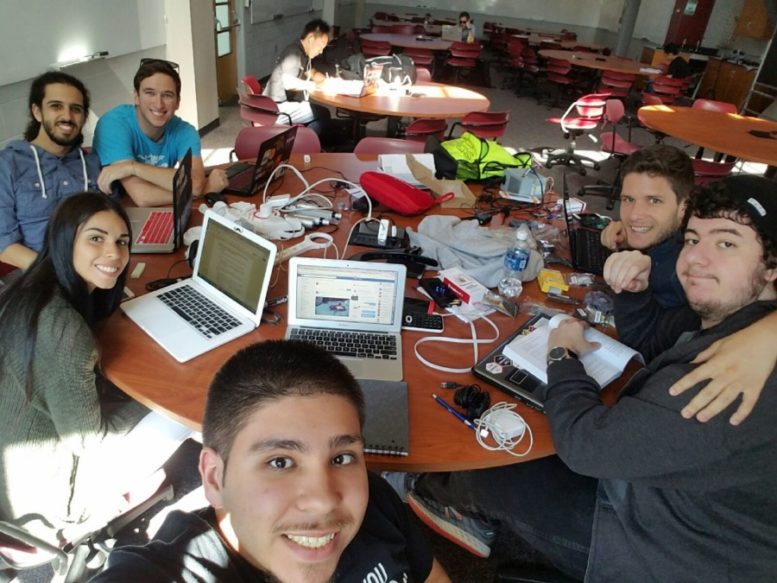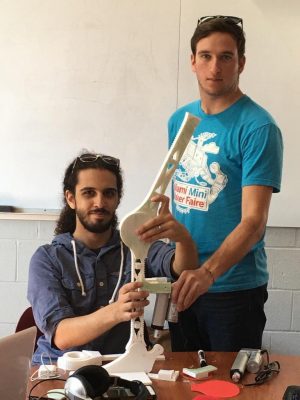
By: Aaron Rodriguez-Pupo
Nearly 50 teams from colleges around the country converged last month on Johns Hopkins University to compete in MedHacks 2.0. Their goal: Develop a piece of technology in under 36 hours that solves a problem in the medical field. Project LegDay, a team of six Honors College students, made an impressive contribution that shot them into the top ten: a fully functioning prototype for a prosthetic leg.
The team of six friends was comprised of Angelo Saraceno and Benjamin Botwin, computer science majors; Jackson Fadely and Hassan Zock-Obregon, mechanical engineering majors; Gabrielle Rivera, a biomedical engineering major; and Joel Greenup, a psychology major.
Greenup was born with spina bifida, a birth defect that has left him paralyzed him from the waist down. He served as the project manager and inspiration for LegDay, which began as a group joke about using a 3D printer to print him a new pair of legs.
The joke was made a reality in just three weeks.
“This entire hackathon was super spontaneous,” said Jackson. Almost all programming and calculations were done at MedHacks since little preparation was allowed beforehand. Parts were printed here using the Honors College 3D printer and Innovation Lab.

The first 12 hours of the hackathon were spent assembling the leg. It took another 16 hours of coding and programming to get the leg to move. Getting it to move properly was another process requiring specific calculations.
The team barely slept throughout the 36-hour ordeal, catching catnaps against the wall or on the floor of the hackathon room.
Industry judges visited the team tables in a process Zock-Obregon described as “science fair-esque.” LegDay received great support, and the judges selected it to move on to the next round.
The second phase of judging involved short presentations from each of the 10 finalists. LegDay used the opportunity to cover some more technical aspects of their new leg.
Safety was one of the most important aspects of its design. The device straps onto the leg as a kind of exoskeleton and could potentially break if either the knee or ankle bends too far forward. To avoid this, the team designed the knee and ankle joints to lock if bent too far, but the design still allows for a full range of normal motion. Software monitors the leg and returns it to an upright position if it receives readings indicating the leg is bending incorrectly or the wearer is falling. Users can customize the machine to fit their own leg size and walking stride. It is lightweight and easily fastens onto the leg using Velcro. All in all, it cost about $300 to make while similar products on the market can cost thousands.
LegDay didn’t make the final cut. Nonetheless, Greenup says, “It was worth it, it was genuinely worth it.” The experience brought the team closer, and they were also able to make connections at the hackathon. Representatives from Texas Medical Center invited them to an upcoming exposition in Texas, tech company Fusiform offered Jackson a job, and I-Biomed contributed some resources to the project.
Project LegDay 2.0 is already in development. Everyone has their sights set on that upcoming exposition in Texas, scheduled for November.
What’s next for the group?
“We’re going to make it into a working leg for Joel,” said Zock-Obregon.





